colour vision III
1/32
There's no tags or description
Looks like no tags are added yet.
Name | Mastery | Learn | Test | Matching | Spaced |
|---|
No study sessions yet.
33 Terms
name the most common/widely used Pseudoisochromatic Plate Test
ishihara’s test for colour deficiency
name some other pseudoisochromatic plate tests (cover in year 2) (3)
HRR Test - good for blue/yellow colour testing
Dvorine Colour Blind Test
CVTME (Colour Vision Testing Made Easy)
explain what the ishiharah test and is and what it tests for
•A booklet that comprises several different pages comprising pseudo-isochromatic plates (24 or 36 plate editions).
•Tests for and sensitive to Red/Green CVD only
what does the ishiharah test NOT test for
does not test for blue/yellow CVD in any wave or form
will miss any possible blue/yellow defects if you only use the ishiharah test so important to use others (HRR)
how does the ishiharah test work? (6)
Ishihara (and other pseudo-isochromatic plates) exploit the confusion lines of CVD.
The test comprises small coloured discs that vary in luminance.
The discs are arranged to form a figure and background.
ask patient to see what number they can see - not all plates have numbers
First plate is a demonstration plate – everyone should see the number (any CVD) – severely visually impaired would not be able to/ those with a VERY low VA
demonstration plate is followed by other types of plates: transformation, vanishing, hidden and classification
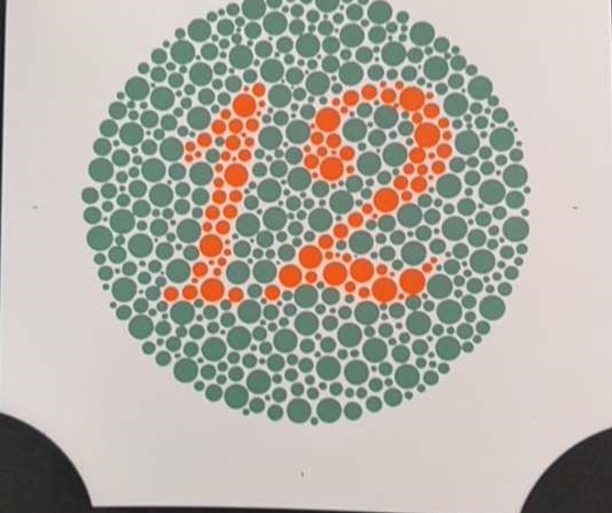
who is this test (ishihara) good for and why
good for children as they will say if they can/cannot see something – as everyone can usually see this - you will know if they are lying etc.
under what conditions should the tests be performed
daylight conditions - by using a special light box/day light bulb
what are the disadvantages of the ishihara test/ what is it not able to do (2)
•No information about severity of defect. Only detects presence (clear at seeing who has a defect and who doesn’t) - sensitive to R/G CVD’s but not the severity of it
•Not useful at separating protan – deutan defects.
what is the criterion for failure of the ishiharah test (3)
Criterion of 4 or more errors is a failure – patient has R/G CVD
Various different criteria. Birch (2001) says FAIL if 2 or more errors (24 plate edition) and if 3 or more errors (38 plate edition)
Normals will only make a couple of errors if that – people with defects will make many errors – not difficult to distinguish between ¾ etc.
how are normals, protanopes and deuteranopes all able to see the number 12 on the demonstration plate even though the colours may look different to them
The luminance difference in the small discs makes the number 12 visible in all cases - This means that even if the color is hard to tell, your eye can still pick up the light vs. dark pattern between the dots in the number and dots in the background - and that’s enough to make out the shape of the "12".
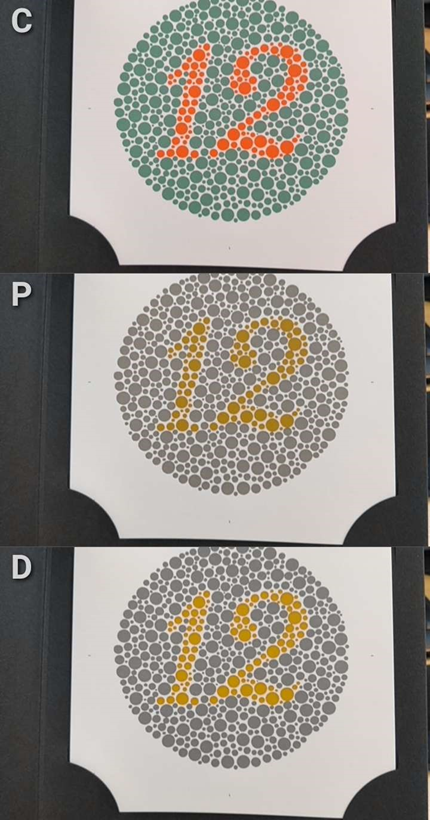
why is luminance noise introduced on purpose to the plates
so people can’t use luminance to see the number on the plates – have to use colour - allows us to successfully test for CVD’s
how does the ishiharah test work for all types of colour blindness / all dichromats / trichromats (2)
the demonstration plate does NOT fall onto any confusion lines (uses color pairs that don’t fall on those lines) for any type of colour blindness
which is why this test works – they can see the number
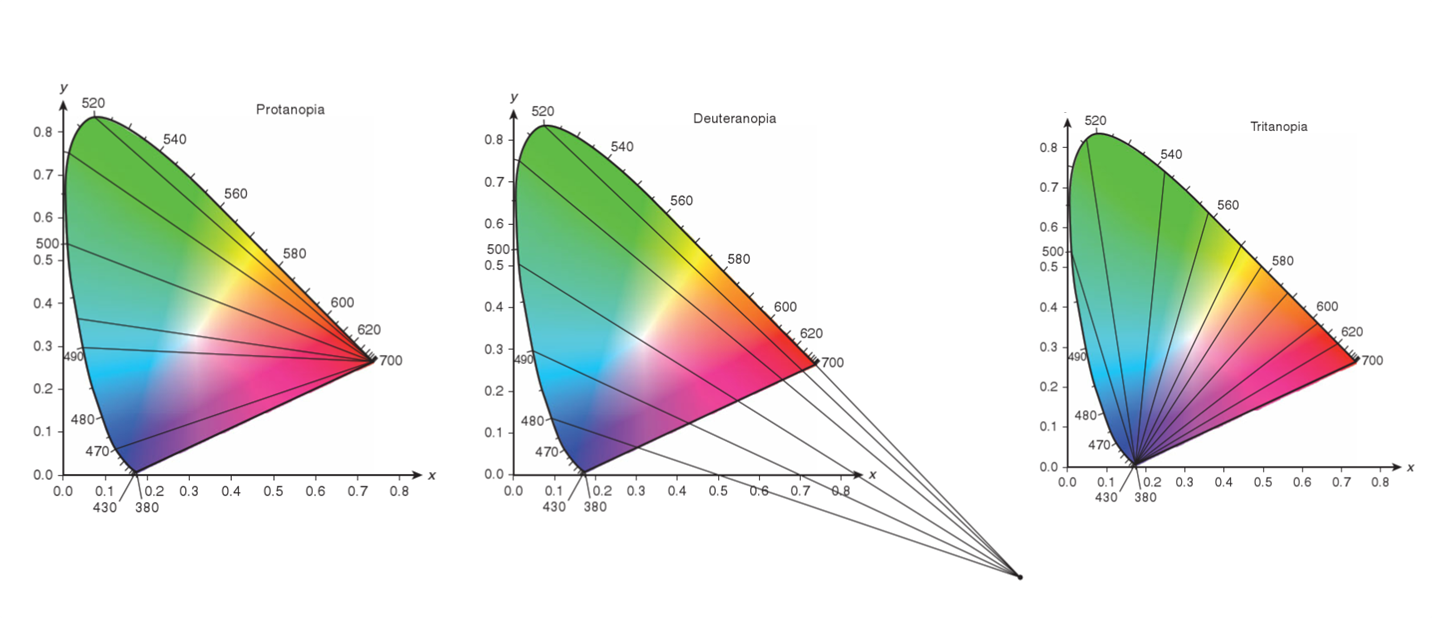
explain vanishing plate
the number will vanish if the person has a R/G defect - so for protanopes and deuteranopes
for normals and tritanopes the number will be visible (6)
explain transformation plates
normals and tritanopes can see the number 29
protanopes and deuteranopes will see the number 70
tritanope can see the number 29 as the test is not designed to find B/Y defects
explain hidden figure plates
normals and tritanopes will see no number
protanopes and deuteranopes will see the number 5
CVD may also report no number - recall that dichromats can sometimes see through camouflage that normals can’t!
explain classification plates
helps to decide if someone is a protanope or a deuteranope - has a protan or deuten defect - not successful in this most of the time
protanope sees 6 / deuteranope sees 2
cant tell between an ope and an anomaly
normals and tritanopes will be able to see the number 26
explain how children plates work in the ishiharah test
used for small children who cannot identify numbers
•there are ‘line’ plates where the line, if seen, can be traced.
(use a new/clean paintbrush – not finger!)
normals will see a line, protanopes and deuteranopes will not be able to see a line
explain the HRR test very briefly (2)
tests for B/Y AND R/G CVD’s
has plates to test for Tritan defects
name the colour arrangement test
(Farnsworth) D15 test
Lanthony Desatured D15 test

what does D15 test results classify people into
•Designed to classify CVD into 2 groups (D=“dichotomous”)
1)Strongly/medium colour deficient
2)Mildly colour deficient or Normal colour vision
can test for B/Y and R/G CVD’s
allows you to differentiate between protans, deutans and tritans - NOT protanopes or anomolaies
use of the D15 test
used a lot for occupational testing
sees if it is safe for someone to work in a particular field - depending if the CVD is strong or mild
why do we plot each coloured cap on a CIE diagram
Each cap has a munsell classification and plot on a cie
To see that some caps fall on confusion lines – these caps will be confused by R/G and B/Y CVD’s
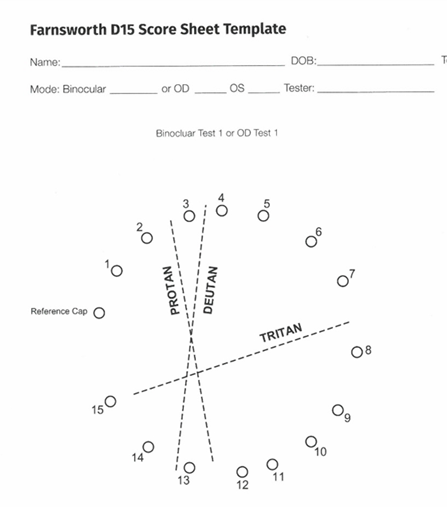
explain HOW the D15 works (5)
•Should be performed under ‘daylight’ conditions
•An arrangement test using different coloured caps
–Task is to rearrange colours in orderly sequence of changing hue
–Instructions should be to arrange in what patient thinks is the natural order beginning with the fixed cap - use the word caps not colours when instructing as can be confusing
–Record results according to number sequence of caps in order
how do you determine if someone has failed the D15 test (6)
Pass the test by having no ‘crossing’ errors or a simple transposition (of caps) –e.g., 3, 4, 6, 5, 7
A simple diametrical crossing from 7 to 15 would still pass
Fail would be more than one crossing error.
About 4-6% of normals fail.
70% of all CVD will fail.
transposition is a small crossing like 6 5 7 instead of 5 6 7 - does not mean a fail
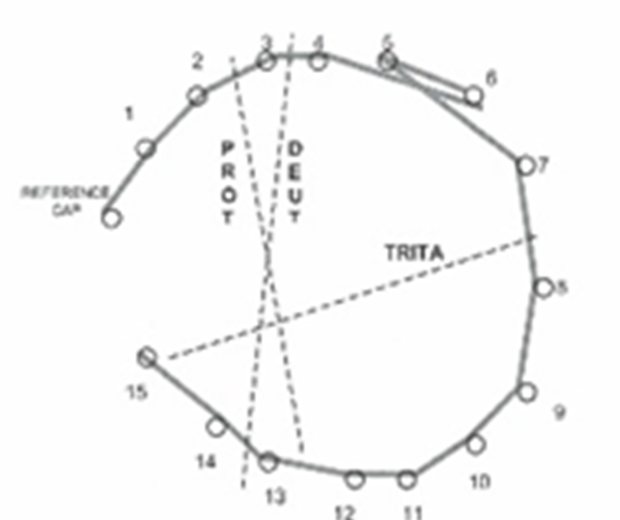
by looking at the results how can you tell if the person is a protan, deutan or tritan
the crossing over lines will be parallel to the protan, deutan and tritan line on the diagram = tells you which one it is
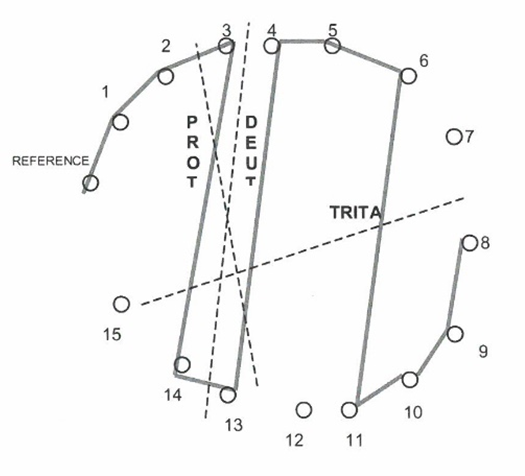
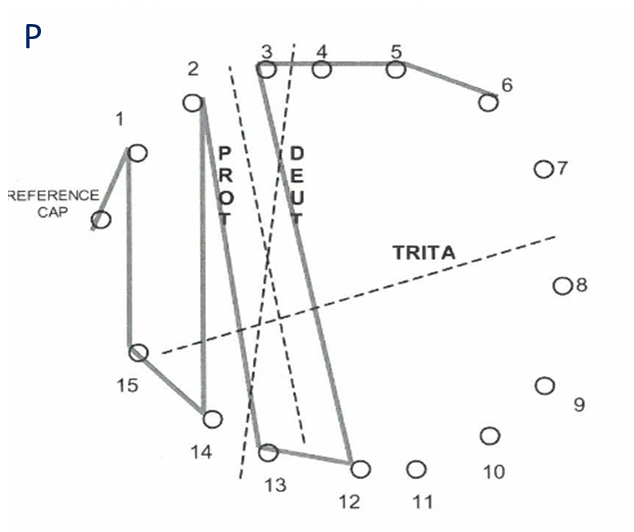
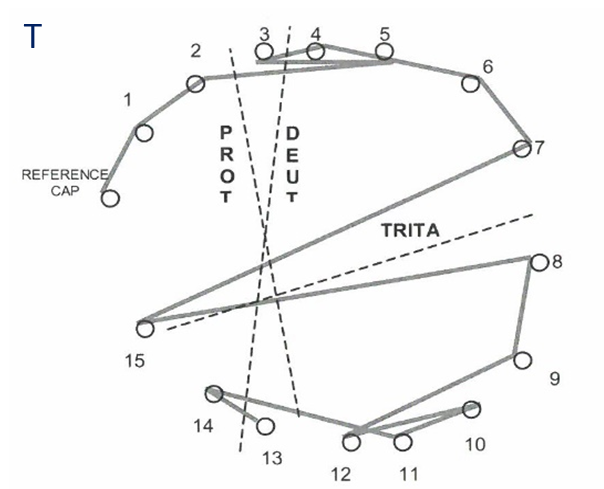
explain the use, classification and how the lanthony d15 test works (5)
Lanthony D-15 Test designed to separate patients into 2 groups: 1)Colour deficient (mild) AND 2)Normal colour perception (normal)
uses less saturated/strong colours than the D15 - colours more close to white on CIE diagram (pastel colours)
Considered more appropriate for use in detection of acquired colour defects
done after the D15 test which tells if strong or mild, then this tells if mild or normal - useful to do if the patient passes the d15 test
can test for protan, deutan and tritan
when would you test for CVD’s (5)
Children on first examination - learning purposes and job in the future (if they want to be a pilot)
When vocational advice is needed.
Certification for visual fitness (e.g., licensing).
When ocular disease is suspected or when assessing colour vision may help in diagnosis.
For primary care a limited number of tests can be helpful.
what does the anomaloscope do
the definitive test for diagnosis of R/G colour vision testing
can differentiate between protanope and protanomaly
what are the main tests used for acquired colour vision testing
The FM100 and other electronically generated tests (CAD: Colour assessment and Diagnosis test; Cambridge Colour Test)
is there any cures for CVD’s (3)
•There is no ‘cure’ as such although some methods may help alleviate some of the problem's CVD experience.
•Use of filters may help differentiate between colours based on changes in luminance or other potential colour cues
eg: enchroma filters put in glasses - can help people with mild CVD’s
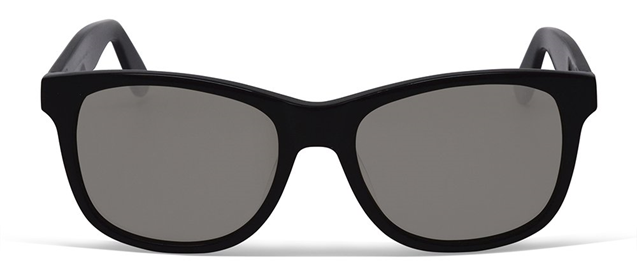
why is enchroma said not to work
•Enchroma do not significantly improve discrimination of colours in CVD.
•They appear to help in isolated regions but also hurt in other isolated regions.
•May help those with mild CVD (anomalous trichromats) scientific evidence is lacking.
what is the impact of blur on CV test results (2)
Minimal impact on Ishihara results up to +6D blur - not important to have the best prescription in when doing ishihara as blur doesn’t affect it
but even slight blur affects Lantern test results
summarise the effect of CVD difficulties in everyday life (4)
•90% of dichromats and almost 2/3rds of anomalous trichromats had trouble with everyday tasks involving colour (fruit colours, seeing if meat is cooked, learning with colour)
•Nearly half of dichromats (50%) and 1 in 5 anomalous trichromats reported difficulty with traffic lights, brake lights etc.
•2 of 37 dichromats were not aware of their CVD compared with 16 of 65 anomalous trichromats.
•Of those who were unaware, some were surprised (mostly ‘anomals’), while others did acknowledge a suspicion.